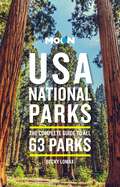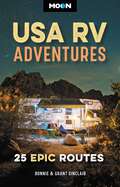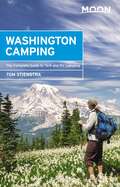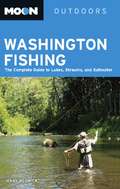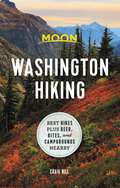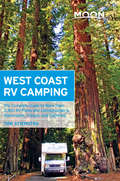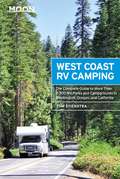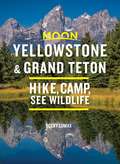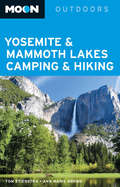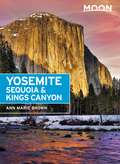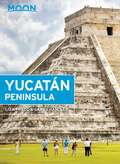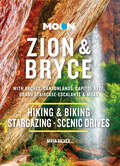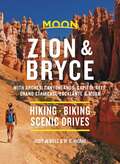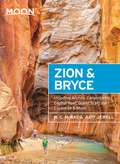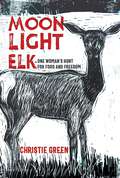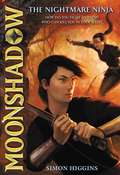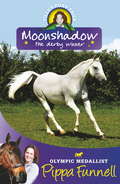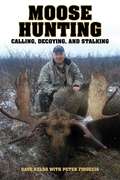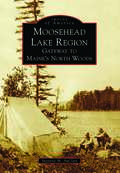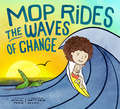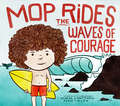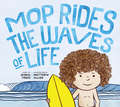- Table View
- List View
Moon USA National Parks: The Complete Guide to All 63 Parks (Travel Guide)
by Becky LomaxThey've been dubbed America's best idea for a reason: get inspired, get outdoors, and discover the wild beauty of the United States with Moon USA National Parks. Inside you'll find:Coverage of all 63 national parks, from the misty mountains of the east and the redwoods of the west to the glaciers of Alaska and volcanoes of Hawaii, organized by region Strategic lists and itineraries: Choose from lists of the best parks for hiking, wildlife, families, and scenic drives or make your way down the list of the top ten national parks experiences across the country The best outdoor adventures in every park, including backpacking, biking, climbing, kayaking, rafting, and more, plus detailed hike descriptions and trail maps marked with distance, duration, effort level, and trailheads National parks road trips with driving times and advice for linking multiple parks, interesting stops between them, and nearby attractions and state parks Comprehensive planning resources: With maps and transportation tips, you'll have the tools to explore each park or region individually, or visit multiple for an epic national parks trip Expert advice from former park guide Becky Lomax on how to avoid crowds, what time of year to visit, and where to stay inside and outside the parks, from campgrounds to hotels Know before you go: Find essential background on climate, terrain, wildlife, history, and safety precautions, plus practical information on park fees, passes, and reservations, including how to obtain and use a National Parks Pass Gorgeous, full-color photos throughout, plus a handy keepsake section for your national parks stamps and a detachable fold-out poster mapWhether you're trekking to striking vistas, rafting a wild river, or camping under the stars, find your park adventure with Moon USA National Parks. For more in-depth information on a specific park, check out one of Moon's national parks travel guides. About Moon Travel Guides: Moon was founded in 1973 to empower independent, active, and conscious travel. We prioritize local businesses, outdoor recreation, and traveling strategically and sustainably. Moon Travel Guides are written by local, expert authors with great stories to tell—and they can't wait to share their favorite places with you. For more inspiration, follow @moonguides on social media.
Moon USA RV Adventures: 25 Epic Routes (Travel Guide)
by Bonnie Sinclair Grant SinclairGet inspired and get ready to hit the road with the ultimate guide to America's best RV road trips! Inside Moon USA RV Adventures you&’ll find:25 flexible RV trip itineraries: Gear up for any adventure with road trip loops, ideas for side trips, and strategies for linking routes together The best routes for national parks, historic sites, natural wonders, beaches, and pet-friendly destinations Can't-miss stops from coast to coast: Camp on the beach in the Florida Keys, follow the ruts on the historic Oregon Trail, and wildlife-watch in Yellowstone. Hike in Acadia with your four-legged friend, take in the colorful wind-swept vistas of the Badlands, and enjoy mountain-peak views with your morning cup of coffee in Colorado Delicious local flavors: From lobster rolls to Key lime pie to the red and green chiles of the Southwest, taste your way across the country—whether you dine in restaurants or your RV kitchen Expert advice from seasoned RV-ers Bonnie and Grant Sinclair Comprehensive planning resources: Easy-to-use maps that highlight where you can (and can&’t) drive an RV, nearby grocery stores for each campground, plus tips for health and safety on the road, navigating weather conditions, RV-ing with pets, and minimizing your environmental impact along the way Gorgeous, full-color photos and a fold-out mapRV basics and essential tips like how to pack, how to pick campgrounds, types of RVs, renting an RV, and more From scenic drives and epic hikes to tranquil campground stops, make your home on the road with Moon USA RV Adventures. About Moon Travel Guides: Moon was founded in 1973 to empower independent, active, and conscious travel. We prioritize local businesses, outdoor recreation, and traveling strategically and sustainably. Moon Travel Guides are written by local, expert authors with great stories to tell—and they can't wait to share their favorite places with you. For more inspiration, follow @moonguides on social media.
Moon Utah: With Zion, Bryce Canyon, Arches, Capitol Reef & Canyonlands National Parks (Travel Guide)
by Judy Jewell W. C. McRaeFrom remote deserts and arid mountain ranges to colorful canyons and world-famous national parks, Moon Utah reveals the best of this adventurous state. Inside you'll find:Strategic itineraries, from a weekend getaway to Salt Lake City to ten days covering the entire state, with strategic advice for history buffs, hikers, ski bums, budget travelers, and moreHow to plan a national parks road trip covering Zion, Bryce Canyon, Arches, Capitol Reef, and CanyonlandsMust-sees and unique experiences: Admire ancient Native American rock art and cliff dwellings, and walk beside fossilized dinosaur footprints. Explore historic Mormon sites in Salt Lake City, or wander through old mining townsThe top outdoor adventures: Hike or mountain bike across canyons, rugged mountain ranges, and glistening salt flats, or hit the slopes at a Park City ski resort. Go rafting down the Colorado River, canyoneering through the Narrows, or climb to the famed Delicate Arch just in time to watch the sun setting over the captivating hoodoosHonest recommendations from Utah experts and lifelong explorers W.C. McRae and Judy Jewell on when to go, where to eat, and where to stay, from ski resorts to budget motels to campgroundsFull-color photos and detailed maps throughoutAccurate, up-to-date information on the landscape, wildlife, and history, and advice for LGBTQ travelers, international visitors, seniors, and travelers with disabilitiesFind your adventure in Utah with Moon's practical advice and local insight.Focusing on the parks? Try Moon Zion & Bryce or Moon Arches & Canyonlands. Hitting the road? Try Moon Southwest Road Trip.
Moon Virginia: With Washington DC (Travel Guide)
by Michaela Riva GaaserudFrom metropolitan cities and misty mountains to colorful coastline and charming small towns, journey through the Old Dominion state with Moon Virginia. Inside you'll find:Flexible itineraries, such as five days visiting Virginia's battlefields and breweries and ten days exploring the whole state, with detailed coverage of Washington DCThe best road trips in Virginia, including the scenic Skyline Drive and the Blue Ridge ParkwayStrategic advice for history buffs, foodies, outdoor adventurers, families, and moreCan't-miss sights and unique experiences: Visit Revolutionary War battlefields and hear the stories behind Civil War landmarks or immerse yourself in history in Colonial Williamsburg. Stroll the Virginia Beach boardwalk or ride the coasters at Busch Gardens. See world-class museums and monuments in the nation's capital, pop into indie boutiques in Richmond, or visit the homes of former presidents like Jefferson and Washington. Hike sections of the Appalachian Trail, explore underground caves, or kayak on the Potomac River. Sample authentic Virginia ham, kick back at a local brewery, and discover the best spots for a romantic getawayExpert advice from Virginia local Michaela Riva Gaaserud on when to go, what to pack, and where to stay, from campgrounds to historic innsThorough background on the culture, weather, wildlife, and historyWith Moon's practical tips and local know-how, you can experience the best of Virginia.Headed to the Smokies? Check out Moon Great Smoky Mountains National Park. Exploring more of the South? Try Moon North Carolina or Moon Charleston & Savannah.
Moon Washington Camping: The Complete Guide to Tent and RV Camping (Moon Outdoors)
by Tom StienstraMoon Travel Guides: Your Adventure Starts HereWhether you're parking the RV or camping in secluded wilderness, explore the great outdoors of the Evergreen State with Moon Washington Camping. Inside you'll find:A Campsite for Everyone: A variety of campgrounds and RV parks, from family-friendly car camping to secluded hike-ins, including dog-friendly and wheelchair accessible optionsRatings and Essentials: All campsites are rated on a scenic scale and marked with amenities like restrooms, trailhead access, picnic areas, laundry, piped water, showers, and playgroundsRecreation Highlights: Discover nearby hiking, swimming, fishing, water-skiing, whitewater rafting, hot springs, and options for winter sportsMaps and Directions: Easy-to-use maps and detailed driving directions for each campgroundTrusted Advice: Expert outdoorsman Tom Stienstra is always on the move, having traveled more than a million miles across Washington and the West over the past 25 yearsTips and Tools: Essentials like equipment, food and cooking, first aid, and insect protection, as well as background information on the climate, landscape, and history of the campsitesComprehensive Coverage: Moon Washington Camping covers the Olympic Peninsula and the Washington Coast, Seattle and Puget Sound, the Northern and Southern Cascades, Northeastern Washington, the Columbia River Gorge and Mount Rainier, and Southeastern WashingtonWhether you're a veteran or a first-time camper, Moon's comprehensive coverage and trusted advice will have you gearing up for your next adventure.Sticking to the RV? Try Moon West Coast RV Camping. Can't get enough of the Pacific Northwest? Try Moon Oregon Camping or Moon Olympic Peninsula.
Moon Washington Fishing: The Complete Guide to Lakes, Streams, and Saltwater
by Terry RudnickWashington native Terry Rudnick knows the best fishing spots in the Evergreen State, from the marine waters of the San Juan Islands-just a short trip from Seattle-to the remote lakes of Northeastern Washington. Full of detailed descriptions of over 600 fishing locations,Moon Washington Fishingleads anglers to the best lakes, reservoirs, rivers, and coasts that the state has to offer, and it includes pages' worth of Rudnick's knowledgeable fishing tips and advice. Complete with helpful regional maps and thorough directions for each location,Moon Washington Fishingprovides all the necessary tools to head outdoors.
Moon Washington Hiking: Best Hikes plus Beer, Bites, and Campgrounds Nearby
by Craig HillCraggy coastal cliffs, towering active volcanoes, and cascading waterfalls: wherever you turn in Washington, adventure awaits. Pack a lunch, lace up your boots, and hit the trails with Moon Washington Hiking. Inside you'll find:Diverse Hiking Options: Whether you plan to take leisurely lakeside walks or challenging journeys around Mount Pilchuck, enjoy outdoor getaways ranging from easy day hikes to multi-day backpacking tripsFind Your Hike: Looking for something specific? Choose from strategic lists of the best hikes for breathtaking waterfalls, spring wildflowers, or hiking with your dog, plus a breakdown of the best hikes by seasonThe Top Outdoor Experiences: Pick alpine wildflowers in a meadow along Mount Rainier's Skyline Trail, or wander through a dense, green rain forest in Olympic National Park. Venture across a suspension bridge to breathtaking canyon views, and glimpse seals, eagles, and deer at a wildlife reserve. Catch a vibrant sunset from a beach dotted with sea stacks, or explore an underground lava tube Nearby Fun: Relax post-hike at a local brewery, savor a plate of fresh oysters, and stargaze before bed at a nearby campgroundEssential Planning Details: Each hike is described in detail and marked with round-trip distance and hiking time, difficulty, terrain type, elevation gain, and access pointsMaps and Directions: Find easy-to-use maps, driving directions to each trailhead, and details on where to parkExpert Advice: Longtime hiker Craig Hill shares his local secrets, unique tips, and honest opinions of each trailTips and Tools: Advice on gear, first aid, and camping permits, plus background information on climate, landscape, and wildlifeWhether you're a veteran or a first-time hiker, Moon's comprehensive coverage and local expertise will have you gearing up for your next adventure.Hitting the road? Check out Moon Pacific Northwest Road Trip!
Moon West Coast RV Camping
by Tom StienstraAward-winning author Tom Stienstra covers more than 1,800 RV parks and campgrounds throughout Washington, Oregon, and California in Moon West Coast RV Camping. Stienstra provides a range of outdoor options that appeal to campers with kids, pets, or recreational equipment, as well as those looking for a beachfront, natural springs, or island retreat. Stienstra also includes his top picks for the Prettiest Lakes, Best Spots for Wildlife-Viewing, and Best Locations for Fishing. With a variety of RV locations, helpful hints, and suggestions, Moon West Coast RV Camping gives travelers the tools they need to create a more personal and memorable camping experience.
Moon West Coast RV Camping: The Complete Guide to More Than 2,300 RV Parks and Campgrounds in Washington, Oregon, and California (Moon Outdoors)
by Tom StienstraPark your RV anywhere from Mission Bay near San Diego to Orcas Island near the Canadian border, and immerse yourself in the wild spirit of the West Coast with Moon West Coast RV Camping. Inside you'll find:A Campsite for Everyone: A variety of RV parks and campgrounds from scenic state parks to convenient roadside stopovers, including dog-friendly and wheelchair accessible optionsRatings and Essentials: All campsites are rated on a scenic scale and marked with amenities like restrooms, trailhead access, picnic areas, laundry, piped water, showers, and playgroundsRecreation Highlights: Discover nearby waterfalls, beaches, historic sites, hot springs, wildlife, and moreMaps and Directions: Easy-to-use maps and detailed driving directions for each campgroundTop RV Parks and Campgrounds: Lists like "Best for Families," "Best for Fishing," and "Best for Hiking" help you choose where to camp in Washington, Oregon, and CaliforniaTrusted Advice: Expert outdoorsman Tom Stienstra is always on the move, having traveled more than a million miles across Washington, Oregon, and California for the past 25 yearsTips and Tools: Essentials like equipment, recreation, first aid, and insect protection, as well as background on the climate, landscape, and history of the campsitesWhether you're a veteran or first-time RV camper, Moon's comprehensive coverage and practical advice will have you gearing up for your next adventure.Sticking to one state? Try Moon California Camping or Moon Oregon Camping. Cruising down the PCH? Check out Moon Pacific Coast Highway Road Trip.
Moon Yellowstone & Grand Teton: Hike, Camp, See Wildlife (Travel Guide)
by Becky LomaxForge your way through forests, across mountain peaks, past geysers, and more with Moon Yellowstone & Grand Teton. Inside you'll find:Flexible Itineraries: Adventure-packed ideas ranging from one day in each national park to a week-long road trip covering bothThe Best Hikes in Yellowstone & Grand Teton: Detailed descriptions, individual trail maps, mileage and elevation gains, and backpacking optionsExperience the Outdoors: Marvel at the steam-spewing Old Faithful geyser or take a horseback ride to panoramic lakeside views. Hike through alpine forests to rushing waterfalls and catch a glimpse of wild bison, elk, wolves, or bears. Bask in the colorful radiance of Grand Prismatic Spring or stroll the boardwalks along Mammoth Hot Springs. Climb to Inspiration Point for breathtaking views of Jackson Hole and Jenny Lake, explore the quirky nearby towns, or discover the best spots to hit the slopes during the winter seasonHow to Get There: Up-to-date information on gateway towns, park entrances, park fees, and toursWhere to Stay: Campgrounds, resorts, and more both inside and outside the parkPlanning Tips: When to go, what to pack, safety information, and how to avoid the crowds, with full-color photos and detailed maps throughoutExpertise and Know-How: Explore both national parks with outdoors expert and former park guide Becky Lomax Helpful background on the indigenous culture, landscape, plants and animals, and history of the regionFind your adventure in Yellowstone & Grand Teton National Parks with Moon.Visiting more of North America's national parks? Try Moon Glacier National Park or Moon USA National Parks.
Moon Yellowstone & Grand Teton: Including Jackson Hole (Travel Guide)
by Becky LomaxFind Your Adventure with Moon Travel Guides!Forge your way through forests, across mountain peaks, past geysers, and more with Moon Yellowstone & Grand Teton. Inside you'll find:Itineraries for every timeline, budget, and travel style, ranging from one day in each national park to a week-long road trip covering bothThe top activities and unique ideas for exploring each park: Marvel at the steam-spewing Old Faithful geyser, or take a horseback ride to panoramic lakeside views. Hike through alpine forests to rushing waterfalls, and catch a glimpse of wild bison, elk, wolves, or bears. Climb to Inspiration Point for breathtaking views of Jackson Hole, explore the quirky nearby towns, or discover the best spots to hit the slopes during the winter seasonStrategies for getting to the parks and traveling between them, with suggestions on where to stop along the way to eat, rest, or exploreExpert tips for hiking, backpacking, mountain biking, kayaking, and more, plus essential packing and health and safety informationDetailed hike descriptions with individual trail maps, each marked by duration, elevation change, and moreValuable insight from Yellowstone expert and seasoned explorer Becky LomaxHonest advice on where to stay inside and outside the parks, including campgrounds, cabins, guest ranches, and resortsUp-to-date information on park fees, passes, and reservationsFull-color photos and detailed maps of each national parkCoverage of gateway cities and towns, including Jackson Hole, Big Sky, Red Lodge, Cody, Lander, and DuBoisRecommendations for families, seniors, solo travelers, international visitors, travelers with disabilities, and traveling with petsThorough background on the wildlife, weather, terrain, hazards and personal safety, and history Experience the parks your way with Moon Yellowstone & Grand Teton's practical tips, boundless activities, and reliable expertise.For more of the Rockies, check out Moon Montana & Wyoming, Moon Colorado, or Moon Idaho. Checking out more national parks? Try Moon Glacier National Park.
Moon Yosemite & Mammoth Lakes Camping & Hiking
by Ann Marie Brown Tom StienstraCalifornia residents Tom Stienstra and Ann Marie Brown extend travelers their firsthand advice on how to find the best places to camp and hike in this vast region, from the pristine meadows and towering granite formations of Yosemite Valley to the alpine waters of the Mammoth Lakes area. Along with their in-depth coverage, Stienstra and Brown offer "best-of" lists-including Best for Fishing, Best for Families, and Best Hikes with a View-ensuring that both outdoors beginners and experts will find the campgrounds and trails to match their skill levels and interests. Complete with clear directions to each location, detailed destination descriptions, difficulty and quality ratings for each hike, and helpful maps,Moon Yosemite & Mammoth Lakes Camping & Hikingprovides campers and hikers with all the necessary tools to head outdoors.
Moon Yosemite, Sequoia & Kings Canyon (Travel Guide)
by Ann Marie BrownExplore granite domes, thundering waterfalls, and towering trees: Moon Yosemite, Sequoia & Kings Canyon reveals the best of these stunning national parks. Inside you'll find:Flexible Itineraries: Unique and adventure-packed ideas for day hikers, winter visitors, families with kids, campers, and more The Best Hikes in Each Park: Detailed hike descriptions, individual trail maps, mileage and elevation gains, and backpacking optionsExperience the Outdoors: Ride the open-air tram through Yosemite Valley or hike downhill from Glacier Point past roaring waterfalls. Drive the legendary Generals Highway or take a scenic bike ride to pristine lakes (and yes, more waterfalls!). Go for a horse-drawn wagon ride on a pioneer history tour or take a rock-climbing lesson. Walk among the goliaths of Sequoia's Giant Forest and stop at a historic lodge for dinner and a well-deserved drinkHow to Get There: Up-to-date information on traveling between the parks, gateway towns, park entrances, park fees, and toursWhere to Stay: From campgrounds and rustic lodges to the Majestic Yosemite Hotel, find the best spots to kick back, both inside and outside the parksPlanning Tips: When to go, what to pack, safety information, and how to avoid the crowds, with full-color photos and detailed maps throughoutExpertise and Know-How from seasoned explorer and outdoor expert Ann Marie BrownFind your adventure in Yosemite, Sequoia, and Kings Canyon national parks with Moon.Visiting more of North America's incredible national parks? Try Moon USA National Parks or Moon Death Valley National Park. Hitting the road? Try Moon California Road Trip.
Moon Yucatán Peninsula (Travel Guide)
by Gary Chandler Liza PradoExperience stunning Maya ruins, dreamy beaches, and epic outdoor thrills, from cenote-diving to kiteboarding, with Moon Yucatán Peninsula. Inside you'll find: Flexible itineraries including a ten-day eco-adventure and a two-week road trip across the whole peninsulaStrategic advice for road-trippers, foodies, wellness seekers, outdoor adventurers, honeymooners, families, and more The top outdoor activities: Kayak through lush mangrove forests, or sign up for a mountain bike tour through the jungle for a peek at hidden ruins, remote beaches, and dazzling marine life. Spend a day relaxing on the beach, dive into crystal-clear cenotes, or try standup paddle-boardingUnique, authentic experiences: Peruse the markets, museums, and churches of Mérida or Tulum, or take a short walk from the shore to visit jaw-dropping Maya ruins. Find the best spots to fill up on authentic salbute and panucho, and stay up late for live music, cocktails, and fire dancers on the beachHonest advice from Yucatán Peninsula experts Liza Prado and Gary Chandler on where to stay, where to eat, how to get around, and how to avoid crowds and support local and sustainable businessesFull-color photos and detailed maps throughout Reliable background on the landscape, climate, wildlife, and history, as well as health and safety advice and common customs and etiquette Handy tools including a Spanish phrasebook and travel tips for families with kids, seniors, travelers with disabilities, and LGBTQ travelersWith Moon's practical tips and local know-how, you can experience the best of the Yucatán Peninsula.Looking for más Mexico? Check out Moon Baja or Moon Mexico City.
Moon Zion & Bryce: Hiking & Biking, Stargazing, Scenic Drives (Moon National Parks Travel Guide)
by Maya SilverSpark your sense of wonder and immerse yourself in the awe-inspiring landscape of Utah's five national parks. Inside Moon Zion & Bryce you'll find:Flexible Itineraries: Unique and adventure-packed ideas ranging from one day in each park to a week-long road trip covering all of them, designed for outdoor adventurers, road-trippers, families, and more The Best Hikes in Utah's National Parks: Individual trail maps, mileage and elevation gains, and backpacking options for Zion, Bryce Canyon, Canyonlands, Arches, Capitol Reef, and Grand Staircase-Escalante Experience the Outdoors: Trek between the thousand-foot walls of the Narrows, hike Angels Landing to unbelievable canyon views, and marvel at hoodoos in Bryce. Soak up the serenity of winter on cross-country skis or take a week-long road trip to hit every park on your list. Contemplate ancient Indigenous rock art throughout the parks, mountain-bike through the desert in Moab, and stay late to spot constellations in the dark sky How to Get There: Up-to-date information on gateway towns like Moab, park entrances, park fees, and tours Where to Stay: Campgrounds, resorts, and more both inside and outside the parks Planning Tips: When to go, what to pack, safety information, and how to avoid the crowds, with full-color photos and easy-to-use maps throughout Expertise and Know-How: Utah-based outdoorswoman Maya Silver shares her tips for travelers who want to backpack, mountain bike, raft, rock climb, hike, and more Find your adventure in Zion and Bryce with Moon. Visiting more of North America's incredible national parks? Try Moon USA National Parks, Moon Yellowstone & Grand Teton, or Moon Best of Grand Canyon. Hitting the road? Try Moon Southwest Road Trip. About Moon Travel Guides: Moon was founded in 1973 to empower independent, active, and conscious travel. We prioritize local businesses, outdoor recreation, and traveling strategically and sustainably. Moon Travel Guides are written by local, expert authors with great stories to tell—and they can't wait to share their favorite places with you. For more inspiration, follow @moonguides on social media.
Moon Zion & Bryce: Hiking, Biking, Scenic Drives (Travel Guide)
by Judy Jewell W. C. McRaeExplore the colorful hoodoos, canyons, and iconic arches of all five of Utah's national parks with Moon Zion & Bryce. Inside you'll find:Flexible Itineraries: Unique and adventure-packed ideas ranging from one day in each park to a week-long road trip covering all of them, designed for outdoor adventurers, road-trippers, families, and moreThe Best Hikes in Utah's National Parks: Individual trail maps, mileage and elevation gains, and backpacking options for Zion, Bryce Canyon, Canyonlands, Arches, Capitol Reef, and Grand Staircase-EscalanteExperience the Outdoors: Snap a pic on a sunrise hike or get your adrenaline pumping on a white-water rafting excursion down the Colorado River. Explore the beautiful remains of ancient Native American rock art throughout the parks or discover the creative, energetic spirit of the nearby town of Moab. Enjoy the serenity of Bryce in winter on cross-country skis or take a week-long summer road trip to hit every park on your listHow to Get There: Up-to-date information on gateway towns like Moab, park entrances, park fees, and toursWhere to Stay: Campgrounds, resorts, and more both inside and outside the parksPlanning Tips: When to go, what to pack, safety information, and how to avoid the crowds, with full-color photos and easy-to-use maps throughoutHelpful resources on Covid-19 and traveling to Utah's national parksExpertise and Know-How: Seasoned explorers W.C. McRae and Judy Jewell share tips for travelers who want to backpack, mountain bike, raft, rock climb, hike, and moreWith Moon Zion & Bryce's expert advice and in-depth coverage, you can find your adventure. Visiting more of North America's incredible national parks? Try Moon USA National Parks, Moon Yellowstone & Grand Teton, or Moon Glacier National Park. Hitting the road? Try Moon Southwest Road Trip. About Moon Travel Guides: Moon was founded in 1973 to empower independent, active, and conscious travel. We prioritize local businesses, outdoor recreation, and traveling strategically and sustainably. Moon Travel Guides are written by local, expert authors with great stories to tell—and they can't wait to share their favorite places with you.For more inspiration, follow @moonguides on social media.
Moon Zion & Bryce: With Arches, Canyonlands, Capitol Reef, Grand Staircase-Escalante & Moab (Travel Guide)
by Judy Jewell W. C. McRaeExplore the colorful hoodoos, canyons, and iconic arches of all five of Utah's national parks with Moon Zion & Bryce. Inside you'll find:Flexible Itineraries: Unique and adventure-packed ideas ranging from one day in each park to a week-long road trip covering all of them, designed for outdoor adventurers, road-trippers, families, and more The Best Hikes in Utah's Parks: Individual trail maps, mileage and elevation gains, and backpacking options for Zion, Bryce Canyon, Canyonlands, Arches, Capitol Reef, and Grand Staircase-Escalante Experience the Outdoors: Snap a pic on a sunrise hike or get your adrenaline pumping on a white-water rafting excursion down the Colorado River. Explore the beautiful remains of ancient Native American rock art throughout the parks or discover the creative, energetic spirit of the nearby town of Moab. Enjoy the serenity of Bryce in winter on cross-country skis or take a week-long summer road trip to hit every park on your listHow to Get There: Up-to-date information on gateway towns like Moab, park entrances, park fees, and toursWhere to Stay: Campgrounds, resorts, and more both inside and outside the parkPlanning Tips: When to go, what to pack, safety information, and how to avoid the crowds, with full-color photos and detailed maps throughoutExpertise and Know-How: Seasoned explorers W.C. McRae and Judy Jewell share tips for travelers who want to backpack, mountain bike, raft, rock climb, hike, and moreWith Moon Zion & Bryce's expert advice and in-depth coverage, you can find your adventure.Visiting more of North America's incredible national parks? Try Moon USA National Parks, Moon Yellowstone & Grand Teton, or Moon Glacier National Park. Hitting the road? Try Moon Southwest Road Trip.
Moonlight Elk: One Woman's Hunt for Food and Freedom
by Christie GreenChristie Green learned to hunt in order to complement the food she grew in her New Mexico garden. As an act of practical agency this fulfilled her needs, yet a restlessness stirred within. She longed for a life defined by something deeper than weekly schedules, work roles, and cultural norms. Could she travel beyond the supposed domain of women and venture into the world of animals, into the wild, where men were said to prevail?Outside the grip of the human realm, the moon beckons to Green to go beyond. Here, hunting in the wild, the moon cycles through her, rising and falling at dawn and dusk, whispering messages from the dark side. Rather than circle the hot insistence of a masculine sun, Green begins to attune to the more elusive, mysterious murmuration of the moon.Animals and dreams, lunar partners, choreograph Green through time and space. She longs to dream, toil, live and love at the edges of the fertile ecotones where she can withdraw inward, retreat like an animal into hiding, and then come into full, radiant view on her own terms.Layer by layer, hunt by hunt, Green peels away societal skins that adhere to a prescribed grid, a manufactured tick of time, a picture of perfection. Tracking and tracing, moving in darkness, watching, smelling, listening, and following the animals, Green sheds the burdens of her domestic self and witnesses the animals defying reason as they walk her into their world, ambling her along, straddling night and day, waking and sleeping. Through them, definitions of gender dissolve and boundaries blur. In the process, Green eclipses western society’s definitions of her as a woman, mother, lover, and entrepreneur, courageously birthing her own independence through a profound connection to the animals and the places they call home.What she sought from these animals was food. What she found was freedom.
Moonshadow #2: The Nightmare Ninja (Moonshadow #2)
by Simon HigginsThe future of medieval Japan is at stake once again. A ruthless and power hungry warlord has set out to destroy Moonshadow, a young ninja spy, and his clan of ninja warriors, the Grey Light Order. Luckily, Moonshadow has Snowhawk, a powerful girl ninja and former rival, at his side. Together, they face bounty hunters, a vengeful gangster, and cunning agents from Snowhawk's former clan. But their greatest enemy is a man who uses no weapons-a deadly ninja who enters his victims' minds in their sleep!Join Moonshadow and Snowhawk in this thrilling sequel to Rise of the Ninja!
Moonshadow the Derby Winner: Book 11
by Pippa FunnellMeet Tilly Redbrow, who doesn't just love horses - she lives, breathes and dreams them too! When Derby winner Moonshadow arrives at Silver Shoe Farm, Tilly jumps at the chance to spend time with him. But Tilly isn't the only person interested in this top-class horse, and a sleepover at the stables reveals just how far some people are prepared to go to get close to him...From Pony Club to riding for the British team, and for every girl who has ever longed for a pony of her own, these delightful, warm and engaging stories are packed with Pippa Funnell's expert advice on everything you ever wanted to know about horses.
Moose Hunting: Calling, Decoying, and Stalking
by Dave Kelso Peter J. FiducciaIn Moose Hunting, expert guide Dave Kelso outlines every skill needed to perfect the art of moose hunting. <P><P>Stalking tactics such as what scents are best at attracting moose and how to properly identify moose vocalization guarantee success for hunters. Nothing is left unsaid thanks to Kelso's dedication to the sport.There are so many variables that can affect hunting success, and Kelso has made sure to cover them all, including:Moose hunting methodsScentsReading a moose's body language and voiceProper hunting gear and clothingWeaponsHunting conditionsWhat to do with your moose after the killAnd much moreVeteran hunters and first-timers from all over can benefit from Moose Hunting, with each chapter featuring different scenarios that could come up at any time while hunting. Anyone interested in hunting moose game can't afford to pass up on Kelso's unmatched knowledge.
Moosehead Lake Region: Gateway to Maine's North Woods (Images of America)
by Suzanne M. AuClairAuthor Suzanne M. AuClair is executive director of the Moosehead Historical Society, where these images are held. She has been writing about Moosehead Lake's North Woods region for 27 years and produced the anthology The Origins, Formation & History of Maine's Inland Fisheries Division.
Mop Rides the Waves of Change: A Mop Rides Story (Emotional Regulation for Kids, Save the Oceans, Surfing for K ids) (Mop Rides #2)
by Jaimal YogisThe second in the Mop Rides series! Surfer kid Mop and his friends are back in a quest to save the ocean with mindfulness, surfing, and a bandMop and his friends are back, this time with a band, The Coconut Heads. Mop is riding high from the lessons he's learned about riding the waves of life: to breathe, ride the good waves, and let the bad waves go by. But just when he feels like he's getting the hang of it, he notices a turtle tangled in plastic at the beach. Paddling out to catch a wave, he sees more plastic, and he can't get rid of his anger. It seems like he's back to square one. But after an epic wipeout, he has a realization: deep down, under the anger, is love. He loves the ocean, and he wants to help keep it clean. But how? Let's just say it involves some party waves and a benefit concert by the Coconut Heads--and it's not just their parents who show up. Celebrated San Francisco surfer-journalist-dad Jaimal Yogis teaches 4-8 year-olds timeless beach wisdom with the continuing story of Mop, a sensitive and fun-loving kid who just wants to be in the ocean.With stylish full-color beachy illustrations from cover to cover by So-Cal surfer Matt Allen.
Mop Rides the Waves of Courage: A Mop Rides Story (Emotional Regulation for Kids) (Mop Rides #3)
by Jaimal YogisThe third in the Mop Rides series! Surfer Mop is back, this time with a case of the jitters that his dad and friends help him tackleMop, his friends, and his dad are back, except this time, Mop is dealing with a case of the jitters. He's nervous to talk in class, and waves that he would usually have no problem riding are feeling too big. Luckily, Mop's dad shows him how to work with his fear. He takes a step back, feels his feelings in his body, and lets the fear pass through without judging it—it's not bad, just different! Before too long, he's back out on his board, and presenting in class again. Celebrated San Francisco surfer-journalist-dad Jaimal Yogis teaches 4-8 year-olds timeless beach wisdom with the continuing story of Mop, a sensitive and fun-loving kid who just wants to be in the ocean.With stylish full-color beachy illustrations from cover to cover by SoCal surfer Matt Allen.
Mop Rides the Waves of Life: A Story of Mindfulness and Surfing (Mop Rides #1)
by Jaimal YogisIf only life could be like surfing! Having "funny" hair and being embarrassed in school is hard, but when little surfer Mop studies the lessons of the waves—breathing, letting the bad waves go by, and riding the good ones—he learns how to bring the mindfulness and joy of surfing into his whole life.Celebrated San Francisco surfer-journalist-dad Jaimal Yogis teaches 4-8 year olds timeless beach wisdom with the story of Mop, a sensitive and fun-loving kid who just wants to be in the ocean. Going to school and navigating classmates can be hard—but all that goes away when little surfer Mop paddles out in the waves. With a few tips from his clever mom, Mop studies the wisdom of the water and learns to bring it into his life on land: taking deep breaths, letting the tough waves pass, and riding the good ones all the way. With newfound awareness and courage, Mop heads back to land—and school—to surf the waves of life.With stylish full-color beachy illustrations from cover to cover.
